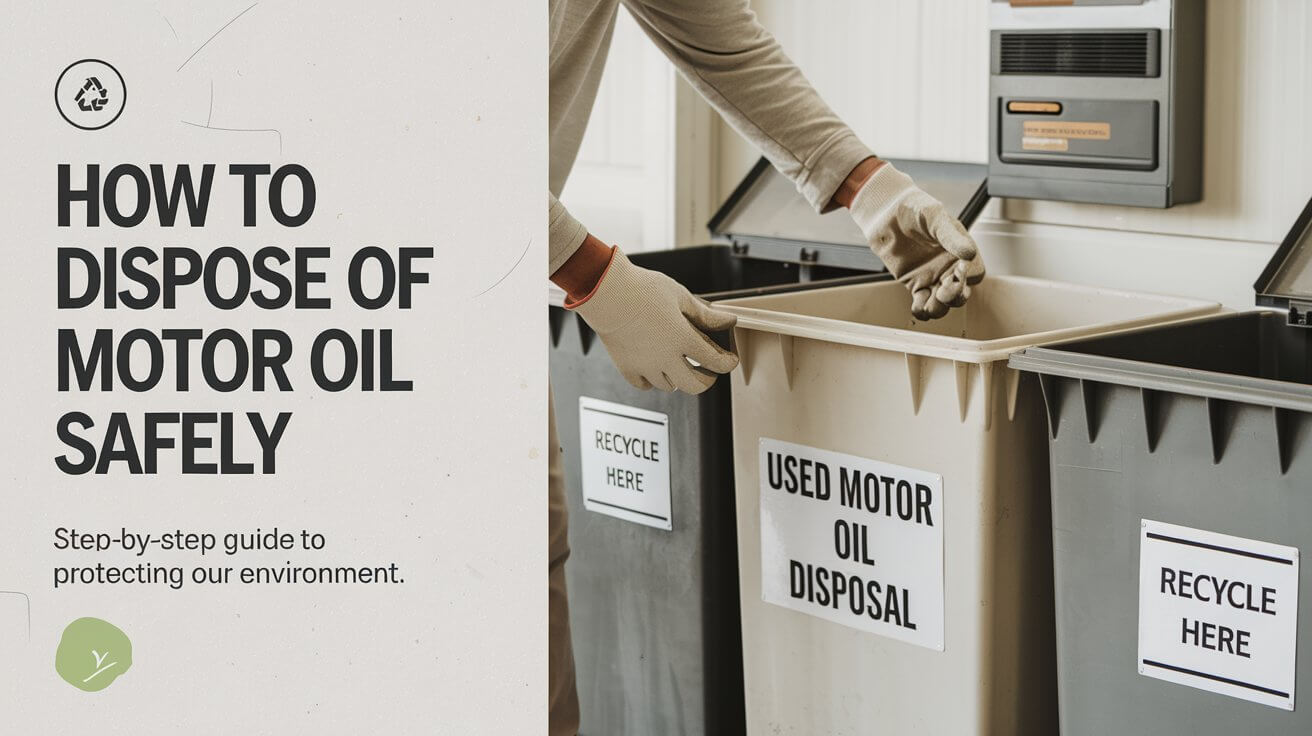How to Dispose of Motor Oil Safely: Complete Step-by-Step Guide

Motor oil is essential for keeping your vehicle’s engine running smoothly, but improper disposal can be hazardous to both the environment and human health. Fortunately, disposing of motor oil in a safe and legal manner is straightforward. This guide will walk you through the necessary steps and provide insights into why it’s so important to handle used oil correctly.
Why Proper Motor Oil Disposal Is Crucial
Environmental Hazards of Improper Disposal
When motor oil is disposed of improperly, it can have serious environmental consequences. A single gallon of oil can contaminate one million gallons of water, causing harm to marine life and polluting drinking water sources. Additionally, oil can seep into the ground and contaminate soil, making it difficult for plants to grow. The toxic compounds in motor oil can also harm wildlife, affecting their habitats and food sources.
Motor oil also contains chemicals such as lead, arsenic, and cadmium. When dumped into storm drains, this toxic mix can enter rivers, lakes, and oceans, posing a threat to aquatic ecosystems. Proper disposal prevents these dangerous pollutants from entering the environment.
Legal Consequences of Improper Disposal
Dumping motor oil illegally is not only harmful to the environment but also against the law. In many countries, including the United States, improper disposal of hazardous waste, such as motor oil, can result in significant fines, potential jail time, or civil penalties. For example, in the U.S., fines can range from hundreds to thousands of dollars, depending on the amount of oil improperly discarded.
Not following local regulations could also mean you may be held responsible for costly environmental cleanups. Taking steps to dispose of oil responsibly ensures that you are in compliance with the law and helps protect the environment.
Step-by-Step Guide to Proper Motor Oil Disposal
Step 1 – Draining and Collecting the Oil
The first step in proper oil disposal starts when you’re draining the used oil from your vehicle or machinery. To do this, you’ll need a drip pan, a funnel, and a container for storage.
- Drain the Oil: Start by carefully removing the oil drain plug and allowing the oil to drain into a pan or drip tray. Make sure the vehicle is on a flat surface to avoid spills.
- Transfer to a Container: Once the oil has been drained, use a funnel to pour the oil into a leak-proof, sealable container. It’s best to use a container made from polyethylene, as it’s resistant to leaks and contamination. Many people choose to use the container that originally held the fresh motor oil.
- Avoid Contamination: Be careful not to mix the oil with any other fluids such as antifreeze, transmission fluid, or water, as this could make it impossible to recycle. Avoid using containers that previously held chemicals like bleach or pesticides.
Step 2 – Handling the Oil Filter
Once you’ve drained the oil, don’t forget about the filter. Oil filters can contain up to 10 ounces of used oil, so it’s crucial to drain them properly before disposal.
- Drain the Filter: Punch a hole in the dome of the used oil filter and let it drain completely into the drip tray.
- Seal and Bag: Once drained, place the oil filter in a sealed plastic bag or container. Some auto parts stores will accept these along with your used motor oil for recycling.
Step 3 – Storing Used Oil Safely
Before transporting the oil, you need to ensure it’s stored correctly. Improper storage could lead to spills or accidents.
- Choose the Right Container: Use a container that seals tightly and can’t be punctured easily. Containers designed for oil storage, such as oil drain pans with attached lids, are ideal.
- Label Clearly: Clearly label the container as “Used Oil” to avoid confusion. This helps both you and the recycling center workers know exactly what’s inside.
- Keep in a Safe Place: Store the container in a cool, dry place, out of reach of children and pets, until you can take it to a recycling center.
Step 4 – Transporting the Oil to a Recycling Center
Once your oil and filter are safely stored, it’s time to find a local recycling center that accepts used motor oil. Here are some tips for transporting it safely:
- Locate a Recycling Facility: Most auto parts stores (e.g., AutoZone, Napa, O’Reilly) and service centers accept used motor oil for free. Additionally, many municipalities have household hazardous waste (HHW) collection centers or curbside pickup programs for used oil.
- Follow Local Regulations: Always check the facility’s guidelines for oil recycling. Some may have restrictions on the quantity of oil accepted per visit (typically five gallons per person per day).
- Never Leave Oil Unattended: Don’t leave used oil at a collection site that’s closed. This is considered illegal dumping, which can result in penalties.
Where to Recycle Used Motor Oil
Local Recycling Programs
Many local governments provide convenient ways to recycle motor oil. You can often find hazardous waste collection sites or recycling centers in your city that accept used oil. Earth911, for example, offers a comprehensive database of recycling centers that can be searched by ZIP code.
Auto Parts Stores and Service Centers
In addition to municipal programs, many auto parts stores accept used motor oil at no charge. Chains like AutoZone, O’Reilly Auto Parts, and Napa Auto Parts offer motor oil recycling services. These businesses make it easy to drop off oil during your regular errands.
Curbside Pickup Options
Some cities provide curbside hazardous waste pickup for used oil. If your city offers this service, check with local authorities to learn about their packaging requirements, as you may need to use specific containers or mark them clearly for disposal.
The Motor Oil Recycling Process
How Used Motor Oil Is Recycled
Motor oil doesn’t wear out—it just gets dirty. That means it can be recycled and reused. The recycling process typically involves the following steps:
- Reconditioning: In this process, oil is filtered to remove impurities. While it may not restore the oil to its original condition, it can extend its life for reuse in certain applications.
- Re-refining: Re-refining is a more intensive process that removes contaminants and returns the oil to its original condition. This method restores the oil to a usable state, allowing it to be reused in vehicles or machinery.
- Burning for Energy: Used motor oil can also be burned as fuel in specially designed furnaces. This process generates heat or electricity, making it a valuable energy source.
Environmental Benefits of Recycling Motor Oil
Recycling used oil reduces the demand for new oil, which lowers the need for crude oil extraction. Additionally, recycling motor oil conserves natural resources, reduces greenhouse gas emissions, and keeps harmful pollutants out of the environment.
For example, recycling just one gallon of used motor oil can yield the same amount of lubricating oil as 42 gallons of crude oil. By recycling your motor oil, you are contributing to environmental sustainability.
Frequently Asked Questions About Motor Oil Disposal
What Happens If Motor Oil Is Mixed with Other Substances?
If motor oil is contaminated with substances like water, antifreeze, or chemicals, it cannot be recycled. Contaminated oil must be treated as hazardous waste, which may require special disposal methods. This is why it’s essential to keep used motor oil separate from other fluids.
How Much Oil Can You Recycle at One Time?
Most recycling centers have limits on the amount of oil they will accept. Typically, they allow individuals to recycle up to five gallons of oil per day. Be sure to check the specific rules at your local recycling center.
Can You Recycle Other Automotive Fluids Along with Motor Oil?
Other automotive fluids, such as transmission fluid, brake fluid, and power steering fluid, can often be recycled. However, these fluids should never be mixed with motor oil. Always store them in separate containers and take them to a recycling center that accepts hazardous automotive waste.
Alternatives to Motor Oil Recycling
Waste-to-Energy Conversion
If recycling isn’t an option, used motor oil can be burned to produce energy. Some facilities use specially designed furnaces to convert waste oil into heat or electricity. This method prevents the oil from being dumped in landfills or waterways and repurposes it for energy generation.
Oil Reconditioning vs. Re-Refining
Reconditioning involves removing contaminants from used oil, making it suitable for lower-grade applications. Re-refining, on the other hand, restores the oil to its original quality, allowing it to be reused in the same capacity as new oil.
Common Mistakes to Avoid
Using Improper Containers
Never store used motor oil in containers that previously held chemicals, food, or drinks. Containers such as milk jugs, bleach bottles, and juice cartons are not suitable for storing oil, as they may cause contamination.
Dumping Oil in Household Recycling Bins
Motor oil is considered hazardous waste and cannot be disposed of in regular recycling or trash bins. Always take it to an appropriate recycling center or collection site.
How Often Should You Change and Recycle Motor Oil?
Frequency of Oil Changes
The frequency of oil changes depends on your vehicle and driving habits. As a general rule, most vehicles require an oil change every 3,000 to 5,000 miles, but some modern cars can go up to 7,500 miles or more between changes. Always consult your vehicle’s owner manual for specific recommendations.
Why Timely Oil Changes Are Essential for Engine Health
Regular oil changes are essential for keeping your engine running smoothly. Dirty oil can cause wear and tear on engine components, leading to costly repairs. By changing and recycling your oil regularly, you can ensure your vehicle’s longevity and protect the environment at the same time.
Conclusion
Disposing of motor oil responsibly is crucial for both environmentaland legal reasons. Not only can it prevent environmental damage, but it also ensures compliance with local laws and regulations. Used motor oil is a recyclable resource that can be reprocessed into new lubricants or used in other industrial applications. By following the correct steps, you help protect the planet and reduce waste.
Taking the time to properly drain, store, and transport your used motor oil, along with any other automotive fluids, ensures that you contribute to environmental sustainability and avoid potentially harmful consequences. It’s a small effort that makes a big difference.




